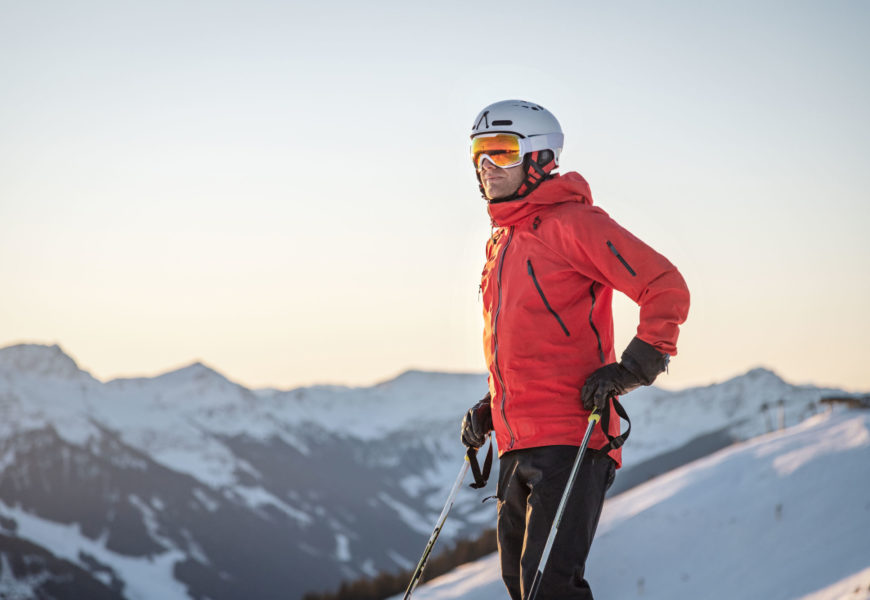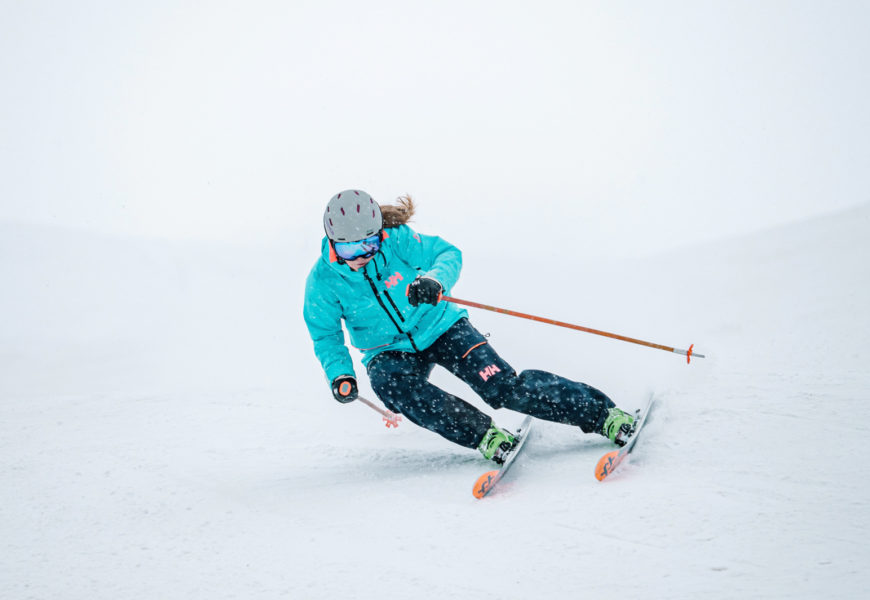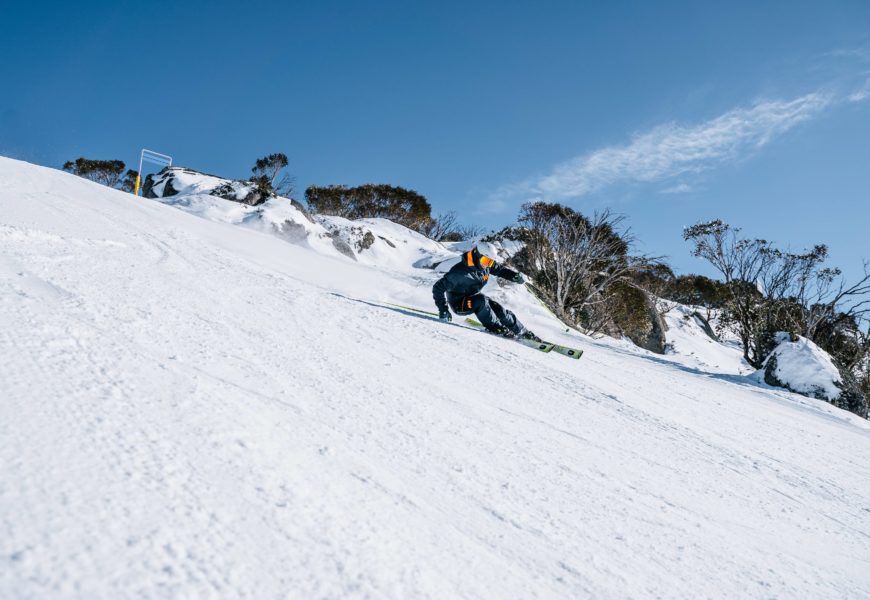How To Be a Better Skier

Votes:
Skiing, like almost anything, becomes more fun as you improve.
The best skiers never stop learning, and every mini breakthrough brings more confidence, more reward and opens up more options for the next time you stand at the top of a mountain.
Most people, however, tend to plateau. Whether you are skidding your way down blue runs or hop turning down narrow chutes, it’s easy to feel like you’ve hit a ceiling in your progress.
Whatever your comfort level, and whatever your goals, here are 10 helpful tips to help you become a better skier and make the most of your time on the snow.
How to be a better skier: 10 tips
- Commit 100% - the mental game is half the battle.
- Fix your stance - balance makes everything a lot easier
- Understand your ski equipment - learn how your gear works
- Understand the laws of gravity in skiing
- Focus on your outside ski – get your body travelling with the skis
- Mix it up - spectrum training will develop your skills faster
- Make drills count - use them with purpose, not just for their own sake
- Ski with flow - carry momentum from one turn to the next
- Know your learning style - make the most of your potential
- Check in regularly – external eyes (and Carv) will help you with your internal focus
1. Commit 100% (skiing mental game)
Commitment lies at the heart of any downhill or adrenaline sport. Anything you approach tentatively, and any move you half make, puts you at a disadvantage before you even start. The skis are moving forward and down the hill, so staying balanced means allowing the body to move forward and down the hill.
Skiing defensively puts you off balance. This means less control and more work for your muscles. Worst of all, it takes away the best feeling in skiing – letting the skis glide.
The opposite can also be dangerous – too much of a gung-ho attitude can quickly put you in a situation that’s difficult to handle.
Train difficult moves on a run that you feel comfortable on. Any skill you learn needs to become second nature. You need to have the skills and confidence to fully commit when you step out of your comfort zone.
Most accidents happen when a skier has either too little or too much confidence in their abilities.
2. Fix your stance
Having a balanced stance makes skiing A LOT easier. Being athletic and centered over your feet gives you the integrity you need to perform skiing manoeuvres, so getting your body position right is crucial.
Stance: Intermediate
- Ski from the ground up. The skis are connected to your feet, so adjustments made with the feet will have an immediate response from the skis.
- The upper body weighs a lot more than the lower, so the less you move it, the more efficient you’ll be. The goal is to keep your feet moving so your weight stays balanced on the arch of your foot, and the upper body just gets taken along for the ride.
- Make a few turns, paying attention to where you feel pressure on the soles of your feet. Try to maintain balance over the arch of the foot by moving the feet to keep them under the body.
- Ski over some rollers or small bumps. Try to get the upper body to follow a smooth straight path, by moving the feet and bending the ankles, knees and hips to keep the balance over the arch of the foot.

Stance: Advanced
Standing flat on your skis, feel contact on the ground with three different points in your foot...
- The back of the heel.
- The ball of the big toe.
- The ball of the little toe.
These three points of contact give you a lot of surface area to stand on, creating a large and stable base.
With that stable base, keeping the foot flat on the floor, pull the tips of the toes up, so your toenails touch the top of your boots. You should feel the shin move to the front of the boot and the muscles in the front of the shin engage.
Being able to bend the ankle and engage the front of the boot (and the front of the ski), while keeping a stable base of support, should give a kind of ‘power steering’ effect. Look for this at the start of each turn.
Check out our video with Kaylin Richardson to see this in action.
Stance: Experts
Learn how to adjust your stance to suit the situation.
Moguls can require a narrower stance – both skis need to be able to fit in the rutline and you want both feet to hit each bump together. Read more.
Ice and steeps can be easier with a wider stance as it makes you harder to topple. Read more.
Powder requires a narrow stance, particularly on thinner skis. Bringing all your surface area together can help the skis float higher in the snow and make it easier to have both feet break and enter the surface together.
More resistance from the snow means we need more tension in the legs to help break through it and keep our feet beneath us, sometimes even pushing our feet forwards in anticipation. Try boot skiing on smooth piste to give an idea of how to stay moving in heavy snow.
Learn to get ready for changes in terrain and conditions. If I’m skiing into a steep bump I want to be tall and extended, so I can absorb some of the pressure when I hit it. If the terrain suddenly falls away I need to be low and ready to extend to keep the skis on the snow.

3. Understand your ski equipment
Intermediate
Skis slide best in the direction the tips are facing. When they glide like this, they bend to manage variations in the snow. They were also made to be steered in round turns (modern shaped skis especially so). Learning to let them run will ease a lot of the strain in the muscles and give a smooth and fluid ride.
Boots are the link between you and your skis; when the boot moves, the ski moves. Having boots that fit correctly, particularly around the lower leg, is essential to be able to ski smoothly; when I move my leg, I want the boot to respond immediately.
NEVER allow the foot or leg to rattle around in the boot.
Check out our article on Ski Boot Fit if you have any questions.
Advanced
The right tools for the job will go a long way for advanced skiers:
- A skinny ski will be much easier to find and hold an edge with and a wider ski will sink less in deep snow.
- Short skis are easy to turn and spin, and longer skis are far more stable at high speeds.
- A ski with a lot of flex will be forgiving and manoeuvrable in the bumps. A torsionally stiff ski will hold carved turns at high edge angles.
While the correct well-fitted boot will add to your performance, they can become a crutch – be careful to avoid simply leaning on the stiff plastic of your boots to hold you up.
Imagine skiing on a ski that was no longer than your boot, in a ski boot made of soft leather, to give you an idea of how active you should be to maintain balance.
4. Understand gravity in skiing
Gravity is what pulls you down the hill and, without it, there would be no skiing. Yet most people are terrified to give in to it, allowing the skis to run.
Learn to see your turns as gravity control, for example:
- As the skis turn from across the hill into the fall line, they pick up speed and run smoothly.
- As the skis are turned out of the fall line and back across the hill, they slow down.
If you accept that you will pick up speed in the first half of the turn, then you can use that momentum to smoothly steer them back the other way and slow down.
Working with gravity and committing to coming with the skis as they find the fall line is the biggest step to progressing as an intermediate skier.
5. Focus on your outside ski
If you feel like you could lift your inside foot, dragging the downhill pole in the snow, then you are off to a good start. To get that ski to grip, you should feel like you would be able to sidestep up the hill without the ski sliding down away from you.
For advanced skiers, shift your balance to the outside by taking it off the inside. You can do this by:
- Lightening/Flexing the inside leg; the foot should unweight, and it will feel like you are allowing the camber back into the ski underfoot.
- Softening the whole of your inside body; allow it to be pulled over your balance point on the outside foot, you may feel a stretch along the side of your torso.
- Increasing the edge angle; the inside leg should bend and the knee float up towards the armpit.
Transitioning to the New Outside Ski: Expert
The shift of balance from the old outside foot to the new shouldn’t be a sudden, clunky move. Think of driving a car; letting the clutch up too fast or stepping hard on the gas pedal will make it jerk and stall. We’re looking for smooth transitions like a smooth gear change.
- At the end of the turn, allow the outside leg to bend while you’re still balanced on it.
- Feel your weight gradually shift from one foot to the other; try to feel the moment your weight is evenly distributed, it should be when the skis are flat.
- Smoothly step onto the new outside ski as the next turn begins.
- Look ahead and learn to time this process so there is no delay between turns.
6. Mix it up and vary intensity
Most competent skiers find a zone they like and stay there. Some love to cruise, and feel in control 100% of the time, others won’t settle for anything other than pushing themselves to the limit every second of the day. Both of these approaches can be useful, but neither will maximise your potential. To master movement patterns and to continually progress you need to train right across the spectrum.
All skiers need to find a balance in the intensity of training, and unfortunately, since we all tend to stick with what we like, we spend a lot more time at the other extreme!
- Spend time skiing slowly while completely in your comfort zone. It’s only here you can focus on making changes to your skiing and refining your technique.
- Spend time in relatively challenging terrain, skiing close to the limit of your control. You need to make mistakes in order to learn to recover, and ultimately to make the micro adjustments that catch mistakes before they happen. Learning what happens to your balance when you push your limits will let you know which skills you need to consolidate on easier terrain.
7. Make drills count
Drills and exercises can accelerate your development if used well.
- Make sure any exercise directly relates to a weakness in your skiing; not everyone needs to touch their knees!
- Pay attention to new feelings when performing the drill, not just the results, so you have a reference point when transitioning back to normal skiing.
- When you get the hang of a drill on easy terrain, vary the speed and turn shape, and take it to more challenging places. You need to train the movement in all situations.
- When you take the drill away make sure you keep the new feeling and try to achieve the same outcome. Some drills can be gradually phased out to make this easier
Check out 2 Skiing Drills To Help Improve Your Technique.

8. Ski with flow
When you watch a master at work, every move they make is linked together and their momentum carries them smoothly along their line. This is where skiing starts to feel like true freedom.
- Look ahead! No one ever got anything positive out of looking at the skis. You want to give the brain time to prepare the body for what comes next, allowing the subconscious to take the wheel and resulting in smoother movements.
- Pole plants and rhythm; on a consistent pitch count in your head as you turn. You want symmetry in your skiing, so the same time and distance between each pole plant. Practice different turn shapes and rhythms.
- Let the skis run flat between each turn, even for a split second. That little bit of glide links everything together nicely.
- As the terrain gets more interesting blend these two together to find your line; if there’s a narrow chute with a wide apron at the end you can let them run – you can catch yourself on the other side. A flat section coming up means you need to carry speed to make it across with some momentum. If the hill drops away and you can’t see the other side, aim to finish a turn coming across there – you can see over the edge and make a plan without having to slam on the brakes.

9. Know your own learning style
Some people learn best by watching experts, others by doing. Some are better served gaining an understanding or overview so they can think for themselves. Which are you?
The more aware you are of your own learning style, the more you can tailor your training, and make the most of your time. Regardless of your personal style, it can be useful to get as much input as possible when training. Next time you want to add a new skill to your toolbox:
- Get out and do it: it will be rough to start, but acquiring and consolidating new skills takes time.
- Watch: pick a skier you’d like to emulate and analyse them. What move are they making (or not making) that less refined skiers aren’t?
- Learn the theory: ask an expert or read up on the causes and effects. It can help guide you through common mistakes.
As you improve and start to refine your skiing, pay more attention to how it feels. Feedback from the snow and your body are your tools to self-analyse; and fix problems while you move.
10. Check in regularly
Whatever your goals, external feedback is essential to keep you on the right track. Analytical tools like Carv will help tell you where you are, and a lesson from a professional will give you an idea where to go next.



